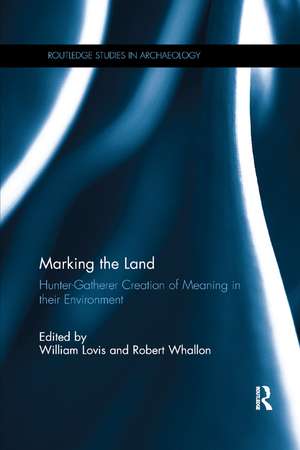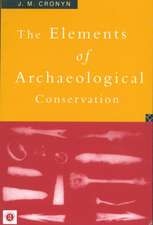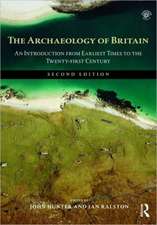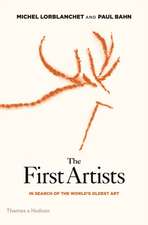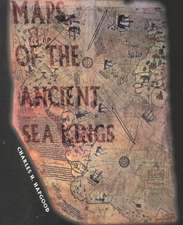Marking the Land: Hunter-Gatherer Creation of Meaning in their Environment: Routledge Studies in Archaeology
Editat de William A Lovis, Robert Whallonen Limba Engleză Paperback – 12 dec 2019
| Toate formatele și edițiile | Preț | Express |
|---|---|---|
| Paperback (1) | 388.72 lei 6-8 săpt. | |
| Taylor & Francis – 12 dec 2019 | 388.72 lei 6-8 săpt. | |
| Hardback (1) | 1113.12 lei 6-8 săpt. | |
| Taylor & Francis – 15 mar 2016 | 1113.12 lei 6-8 săpt. |
Din seria Routledge Studies in Archaeology
- 18%
 Preț: 643.87 lei
Preț: 643.87 lei -
 Preț: 310.22 lei
Preț: 310.22 lei -
 Preț: 326.26 lei
Preț: 326.26 lei -
 Preț: 342.68 lei
Preț: 342.68 lei -
 Preț: 309.65 lei
Preț: 309.65 lei - 26%
 Preț: 766.16 lei
Preț: 766.16 lei - 18%
 Preț: 1108.37 lei
Preț: 1108.37 lei -
 Preț: 384.59 lei
Preț: 384.59 lei -
 Preț: 483.49 lei
Preț: 483.49 lei - 30%
 Preț: 822.76 lei
Preț: 822.76 lei -
 Preț: 389.38 lei
Preț: 389.38 lei - 25%
 Preț: 773.99 lei
Preț: 773.99 lei - 18%
 Preț: 1062.62 lei
Preț: 1062.62 lei -
 Preț: 423.30 lei
Preț: 423.30 lei -
 Preț: 383.50 lei
Preț: 383.50 lei -
 Preț: 388.34 lei
Preț: 388.34 lei -
 Preț: 383.50 lei
Preț: 383.50 lei - 18%
 Preț: 1108.42 lei
Preț: 1108.42 lei - 18%
 Preț: 1064.70 lei
Preț: 1064.70 lei -
 Preț: 389.38 lei
Preț: 389.38 lei - 18%
 Preț: 1059.14 lei
Preț: 1059.14 lei - 18%
 Preț: 1113.16 lei
Preț: 1113.16 lei - 18%
 Preț: 1114.70 lei
Preț: 1114.70 lei -
 Preț: 492.54 lei
Preț: 492.54 lei - 18%
 Preț: 1109.18 lei
Preț: 1109.18 lei - 25%
 Preț: 769.55 lei
Preț: 769.55 lei -
 Preț: 480.62 lei
Preț: 480.62 lei -
 Preț: 469.34 lei
Preț: 469.34 lei - 25%
 Preț: 767.89 lei
Preț: 767.89 lei - 18%
 Preț: 1072.71 lei
Preț: 1072.71 lei - 25%
 Preț: 770.62 lei
Preț: 770.62 lei - 25%
 Preț: 823.99 lei
Preț: 823.99 lei - 21%
 Preț: 256.87 lei
Preț: 256.87 lei - 18%
 Preț: 1060.52 lei
Preț: 1060.52 lei -
 Preț: 434.63 lei
Preț: 434.63 lei -
 Preț: 485.46 lei
Preț: 485.46 lei
Preț: 388.72 lei
Nou
Puncte Express: 583
Preț estimativ în valută:
74.39€ • 77.38$ • 61.41£
74.39€ • 77.38$ • 61.41£
Carte tipărită la comandă
Livrare economică 14-28 aprilie
Preluare comenzi: 021 569.72.76
Specificații
ISBN-13: 9780367874230
ISBN-10: 0367874237
Pagini: 304
Dimensiuni: 156 x 234 x 16 mm
Greutate: 0.43 kg
Ediția:1
Editura: Taylor & Francis
Colecția Routledge
Seria Routledge Studies in Archaeology
Locul publicării:Oxford, United Kingdom
ISBN-10: 0367874237
Pagini: 304
Dimensiuni: 156 x 234 x 16 mm
Greutate: 0.43 kg
Ediția:1
Editura: Taylor & Francis
Colecția Routledge
Seria Routledge Studies in Archaeology
Locul publicării:Oxford, United Kingdom
Cuprins
1. Hunter-Gatherer Landscape Perception and Landscape “Marking”: The Multidimensional Construction of Meaning
William A. Lovis and Robert Whallon
Section I: The Northern Latitudes
2. Initializing the Landscape: Chipewyan Construction of Meaning in a Recently Occupied Environment
Robert Jarvenpa and Hetty Jo Brumbach
3. Places on the Blackfoot Homeland: Markers of Cosmology, Social Relationships and History
Gerald A. Oetelaar
4. Markers in Space and Time: Reflections on the Nature of Place Names as Events in the Inuit Approach to the Territory
Claudio Aporta
5. Inuksuk, Sled Shoe, Placename: Past Inuit Ethnogeographies
Peter J. Whitridge
6. Network Maintenance in Big Rough Spaces with Few People: The Labrador Innu-Naskapi or Montagnais
William A. Lovis
Section II: The Southern Latitudes
7. Physical and Linguistic Marking of the Seri Landscape – Are They Connected?
Carolyn K. O’Meara
8. Bonescapes: Engaging People and Land with Animal Bones among South American Tropical Foragers
Gustavo G. Politis
9. Unfolding Cultural Meanings: Wayfinding Practices Among the San of the Central Kalahari
Akira Takada
10. Continuity and Change in Warlpiri Practices of Marking the Landscape
Petronella Vaarzon-Morel
11. Signaling Presence: How Batek and Penan Hunter-Gatherers in Malaysia Mark the Landscape
Lye Tuck Po
Section III: Synthesis
12. Marked Sacred Places of Hunter-Gatherer Bands
Robert Whallon
13. Hunter-Gatherer Landscape Perception and Landscape “Marking”: The Multidimensional Construction of Meaning
Robert Whallon and William A. Lovis
William A. Lovis and Robert Whallon
Section I: The Northern Latitudes
2. Initializing the Landscape: Chipewyan Construction of Meaning in a Recently Occupied Environment
Robert Jarvenpa and Hetty Jo Brumbach
3. Places on the Blackfoot Homeland: Markers of Cosmology, Social Relationships and History
Gerald A. Oetelaar
4. Markers in Space and Time: Reflections on the Nature of Place Names as Events in the Inuit Approach to the Territory
Claudio Aporta
5. Inuksuk, Sled Shoe, Placename: Past Inuit Ethnogeographies
Peter J. Whitridge
6. Network Maintenance in Big Rough Spaces with Few People: The Labrador Innu-Naskapi or Montagnais
William A. Lovis
Section II: The Southern Latitudes
7. Physical and Linguistic Marking of the Seri Landscape – Are They Connected?
Carolyn K. O’Meara
8. Bonescapes: Engaging People and Land with Animal Bones among South American Tropical Foragers
Gustavo G. Politis
9. Unfolding Cultural Meanings: Wayfinding Practices Among the San of the Central Kalahari
Akira Takada
10. Continuity and Change in Warlpiri Practices of Marking the Landscape
Petronella Vaarzon-Morel
11. Signaling Presence: How Batek and Penan Hunter-Gatherers in Malaysia Mark the Landscape
Lye Tuck Po
Section III: Synthesis
12. Marked Sacred Places of Hunter-Gatherer Bands
Robert Whallon
13. Hunter-Gatherer Landscape Perception and Landscape “Marking”: The Multidimensional Construction of Meaning
Robert Whallon and William A. Lovis
Notă biografică
William Lovis, Professor, Department of Anthropology and Curator of Anthropology, MSU Museum, Michigan State University
Robert Whallon, Professor, Department of Anthropology and Curator of Mediterranean Prehistory, Museum of Anthropological Archaeology, University of Michigan
Robert Whallon, Professor, Department of Anthropology and Curator of Mediterranean Prehistory, Museum of Anthropological Archaeology, University of Michigan
Recenzii
‘This indispensable theoretical and empirical companion to editors Brian Codding and Karen Kramer's Why Forage?(CH, Jan'17, 54-2326) focuses on understanding the multidimensional bases for hunter-gatherer perceptions and constructions of environmental value and meaning. Thirteen essays are appropriately divided among specialists in archaeology, ethnography/ethnology, ethnoarchaeology, and anthropological linguistics. They convincingly demonstrate that the creation, marking, and maintenance of sacred places help to "embed patterns of behavior and behavioral responses that articulate with environmental variability [both spatial and temporal] in an adaptive way." Excellent addition to the archaeological and ethnographic literature on hunting-gathering societies. Summing Up: Essential. Upper-division undergraduates and above.’ - B. Tavakolian, Denison University, in CHOICE
"This volume should be in university libraries, and there are enough outstanding individual papers and enough topical variety and theoretical coherence overall to make this a useful addition to personal libraries." - Aubrey Cannon, McMaster University, Canada
"This volume should be in university libraries, and there are enough outstanding individual papers and enough topical variety and theoretical coherence overall to make this a useful addition to personal libraries." - Aubrey Cannon, McMaster University, Canada
Descriere
Marking the Land investigates physical landscape marking by hunter-gatherers. When and why do hunter-gatherer groups of varying sociocultural complexity and scale place markers on their landscape? When and why are such markers limited to simple, informational signs? When and why are markers invested with symbolic meaning? And when and w
